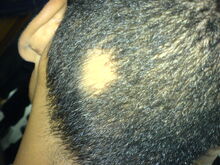Assessment |
Biopsychology |
Comparative |
Cognitive |
Developmental |
Language |
Individual differences |
Personality |
Philosophy |
Social |
Methods |
Statistics |
Clinical |
Educational |
Industrial |
Professional items |
World psychology |
Clinical: Approaches · Group therapy · Techniques · Types of problem · Areas of specialism · Taxonomies · Therapeutic issues · Modes of delivery · Model translation project · Personal experiences ·
Alopecia areata head.jpg|
| ICD-10 | L63 | |
|---|---|---|
| ICD-9 | 704.01 | |
| OMIM | 104000 | |
| DiseasesDB | 430 | |
| MedlinePlus | 001450 | |
| eMedicine | derm/14 | |
| MeSH | {{{MeshNumber}}} | |
Alopecia areata is a form of hair loss from areas of the body, usually from the scalp. Because it causes bald spots on the head, especially in the first stages, it is sometimes called spot baldness. In 1–2% of cases, the condition can spread to the entire scalp (Alopecia totalis) or to the entire epidermis (Alopecia universalis).
Types[]

A photo of a woman with Alopecia Areata Totalis
- Alopecia areata monolocularis describes baldness in only one spot. It may occur anywhere on the head.
Alopecia areata is a form of hair loss from areas of the body, usually from the scalp. Because it causes bald spots on the head, especially in the first stages, it is sometimes called spot baldness. In 1–2% of cases, the condition can spread to the entire scalp (Alopecia totalis) or to the entire epidermis (Alopecia universalis). April 14th is Children with Alopecia Day. * Alopecia areata multilocularis refers to multiple areas of hair loss.
- If the patient loses all the hair on his/her scalp, the disease is then called Alopecia areata totalis.
- If all body hair, including pubic hair, is lost, the diagnosis then becomes Alopecia areata universalis.
- The disease may also be limited only to the beard (Alopecia areata barbae).
Causes[]
Alopecia areata is thought to be an autoimmune disease in which the body mistakenly treats its hair follicles as foreign tissue and suppresses or stops hair growth. It is not contagious but may be hereditary—there are a few recorded cases of babies being born with congenital alopecia areata. As with most autoimmune diseases, Alopecia areata is associated with increased risk of developing other autoimmune diseases, specifically systemic lupus erythematosus or SLE.
Diagnosis[]

Alopecia areata
First symptoms are small, soft, bald patches which can take just about any shape but are most usually round. Initial presentation most commonly occurs in the late teenage years and young children, but can happen with people of all ages. It most often affects the scalp but may occur on any hair-bearing part of the body. There may be different skin areas with hair loss and regrowth in the same body at the same time. It also may go into remission for a time, or permanently.
Another presentation of the condition are exclamation point hairs. Exclamation point hairs are hairs that become narrower along the length of the strand closer to the base, producing a characteristic 'exclamation point' appearance.
One diagnostic technique applied by medical professionals is to gently tug at a handful of hair along the edge of a patch with less strength than would be required to pull out healthy hair. In healthy hair, no hair should fall out or ripped hair should be distributed evenly across the tugged portion of the scalp. In cases of Alopecia, hair will tend to pull out easier along the edge of the patch where the follicles are already being attacked by the body's immune system than away from the patch where they are still healthy. Professionals will usually remind patients that the hair that is pulled out would eventually fall naturally. The test is conducted only once to identify the condition and rule out a simple localized hairloss condition.
Treatment[]
About 50% of patients hair will regrow in one year without any treatment. If the affected region is small, it is reasonable to observe the progression of the illness as the problem often spontaneously regresses and the hair grows back. In cases where there is severe hair loss, there has been limited success treating alopecia areata with clobetasol or fluocinonide, steroid injections or cream. Steroid injections are commonly used in sites where there are small areas of hair loss on the head or especially where eyebrow hair has been lost. Some other medications used are minoxidil, irritants (anthralin or topical coal tar), and topical immunotherapy cyclosporine, each of which are sometimes used in different combinations.
Prognosis[]
Effects of alopecia areata are mainly psychological (loss of self image due to hair loss). However, patients also tend to have a slightly higher incidence of asthma, allergies and atopic dermal ailments and even hypothyroidism. Loss of hair also means that the scalp burns more easily in the sun. Loss of nasal hair increases severity of hay fever and similar allergic conditions. They may also have aberrant nail formation because keratin forms both hair and nails.
Episodes of alopecia areata before puberty predispose one to recurrent episodes after puberty. Pitting of the fingernails can hint at a more severe or prolonged course.
Initial stages may be kept from increasing by applying topical corticosteroids. However, since the exact mechanisms are not ultimately understood, there is no known cure to date. Hair implants may help covering bald spots, but cannot guarantee satisfactory outcome, since the bald areas might expand. Wigs should be prescribed if patients, especially female patients, mention social discomfort.
It is widely believed that alopecia areata is an autoimmune disorder, in which certain hair follicles are targeted by the body's own immune system. There is evidence that T cell lymphocytes cluster around these follicles, causing inflammation and subsequent hair loss.
Some non-clinical treatment results have been observed through the ingestion of natural anti-inflammatory agents, particularly blackcurrant and borage oils in caplet form, and zinc supplement tablets.
Psychosocial issues[]
Alopecia can certainly be the cause of psychological stress. Because hair loss can lead to significant appearance changes, individuals may experience social phobia, anxiety, and depression. In severe cases where the chance of hair regrowth is slim, individuals need to adapt to the condition, rather than look for a cure. There is currently little provision for psychological treatment for people afflicted with alopecia.
Notable people with the condition[]
- Jason Alexander [How to reference and link to summary or text]
- Edith Bouvier Beale [How to reference and link to summary or text]
- Humphrey Bogart [How to reference and link to summary or text]
- Gustavo Chacín [How to reference and link to summary or text]
- Pierluigi Collina [How to reference and link to summary or text]
- Larry David [How to reference and link to summary or text]
- Sean Daley [How to reference and link to summary or text]
- David Ferrie [How to reference and link to summary or text]
- Alan Khan [How to reference and link to summary or text]
- Matt Lucas [How to reference and link to summary or text]
- Dave McPherson [How to reference and link to summary or text]
- Gail Porter [[1]]
- Christopher Reeve [How to reference and link to summary or text]
- John D. Rockefeller [How to reference and link to summary or text]
- Seal [How to reference and link to summary or text]
- Charlie Villanueva [How to reference and link to summary or text]
- Duncan Goodhew [How to reference and link to summary or text]
- Billy Zane [How to reference and link to summary or text]
- Patrick Stewart [How to reference and link to summary or text]
- Rasheed Wallace [How to reference and link to summary or text]
- Steve 'Stone Cold Steve Austin' Williams [How to reference and link to summary or text]
- Jerry Holkins [How to reference and link to summary or text]
- Andy Parsons [How to reference and link to summary or text]
- Stephen Hicks [How to reference and link to summary or text]
- Vikram Bhatt
See also[]
- Alopecia totalis
- Alopecia universalis
- Baldness
External links[]
- Fighting Alopecia Areata Club Club dedicated to funding Alopecia research and increasing public knowledge.
- Alopecia UK
- Alopecia Ireland
- National Alopecia Areata foundation
- National Institute of Arthritis and Musculoskeletal and Skin Diseases at NIH
- VisualDxHealth: medical information and images of Alopecia Areata
- DermAtlas 42
Diseases of the skin and subcutaneous tissue (integumentary system) (L, 680-709) | |
|---|---|
| Infections |
Staphylococcus (Staphylococcal scalded skin syndrome, Impetigo, Boil, Carbuncle) - Cellulitis (Paronychia) - Acute lymphadenitis - Pilonidal cyst - Corynebacterium (Erythrasma) |
| Bullous disorders |
Pemphigus - Pemphigoid (Bullous pemphigoid) - Dermatitis herpetiformis |
| Dermatitis and eczema |
Atopic dermatitis - Seborrhoeic dermatitis (Dandruff, Cradle cap) - Diaper rash - Urushiol-induced contact dermatitis - Contact dermatitis - Erythroderma - Lichen simplex chronicus - Prurigo nodularis - Itch - Pruritus ani - Nummular dermatitis - Dyshidrosis - Pityriasis alba |
| Papulosquamous disorders |
Psoriasis (Psoriatic arthritis) - Parapsoriasis (Pityriasis lichenoides et varioliformis acuta, Pityriasis lichenoides chronica) - Pityriasis rosea - Lichen planus - Pityriasis rubra pilaris |
| Urticaria and erythema |
Urticaria (Dermatographic urticaria, Cholinergic urticaria) - Erythema (Erythema multiforme, Stevens-Johnson syndrome, Toxic epidermal necrolysis, Erythema nodosum, Erythema annulare centrifugum, Erythema marginatum) |
| Radiation-related disorders |
Sunburn - Actinic keratosis - Polymorphous light eruption - Radiodermatitis - Erythema ab igne |
| Disorders of skin appendages |
nail disease: Ingrown nail - Onychogryposis - Beau's lines - Yellow nail syndrome follicular disorders: Alopecia areata (Alopecia universalis) - Androgenic alopecia - Telogen effluvium - Lichen planopilaris - Trichorrhexis nodosa - Hypertrichosis (Hirsutism) - Acne vulgaris - Rosacea (Perioral dermatitis, Rhinophyma) - Epidermoid cyst - Sebaceous cyst - Pseudofolliculitis barbae - Hidradenitis suppurativa sweat disorders: Miliaria - Anhidrosis - Body odor - Chromhidrosis |
| Other |
pigmentation (Vitiligo, Melasma, Freckle, Café au lait spot, Lentigo/Liver spot) - Seborrheic keratosis - Acanthosis nigricans - Callus - Pyoderma gangrenosum - Bedsore - Keloid - Granuloma annulare - Necrobiosis lipoidica - Granuloma faciale - Lupus erythematosus - Morphea - Calcinosis cutis - Sclerodactyly - Ainhum - Livedoid vasculitis |
|
see also congenital (Q80-Q84, 757) | |
| This page uses Creative Commons Licensed content from Wikipedia (view authors). |